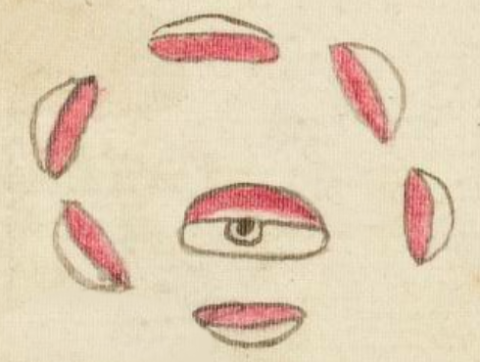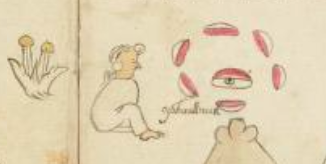Yohualtecatl (Azca15)
This painted black-line drawing of the compound glyph for the ethnic term Yohualtecatl (“Person from Yohuallan”) shows a round (yahualli) group of stars (likely citlalin), indicating nighttime (yahualli). The circle of stars provides a near homophone to support the ethnic label (person from Yohuallan) as a phonetic complement. The -tecatl suffix (person from) is perhaps implicit in the inclusion of a person next to the circle of stars (see the contextualizing image).
Stephanie Wood
The star in the middle of the circle is a starry eye, with a black and white pupil and iris, with a red eyelid. The circle of six stars around this starry eye are flattened eyes, just red and white, and lacking the iris and pupil. See Ixtli (Mdz51r) to get a sense of the earlier way of drawing and painting a starry eye. Night skies in the Codex Mendoza are typically a circular arrangement of starry eyes, also shown below.
Stephanie Wood
Stephanie Wood
post-1550, possibly from the early seventeenth century.
Jeff Haskett-Wood
estrellas, noche, ojos, etnicidades

yohual(li), nighttime, https://nahuatl.wired-humanities.org/content/yohualli
yahual(li), something round, https://nahuatl.wired-humanities.org/content/yahualli
-tecatl, person from, https://nahuatl.wired-humanities.org/content/tecatl
persona de Yohuallan
Stephanie Wood
The Codex Azcatitlan is also known as the Histoire mexicaine, [Manuscrit] Mexicain 59–64. It is housed in the Bibliothèque Nationale de France, and hosted on line by the World Digital Library and the Library of Congress, which is “unaware of any copyright or other restrictions in the World Digital Library Collection.”
https://www.loc.gov/resource/gdcwdl.wdl_15280/?sp=15&st=image
The Library of Congress is “unaware of any copyright or other restrictions in the World Digital Library Collection.” But please cite Bibliothèque Nationale de France and this Visual Lexicon of Aztec Hieroglyphs.






